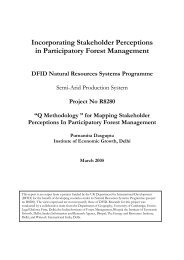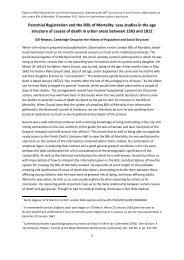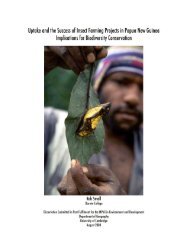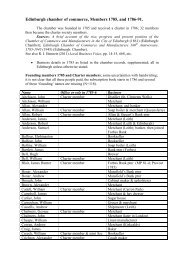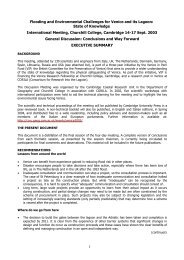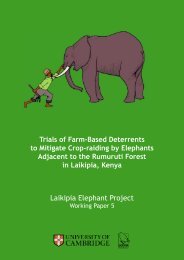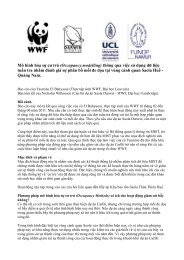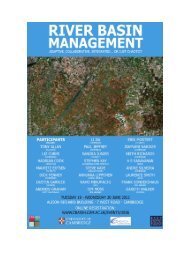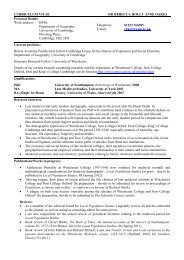An Assessment of Elephant-Compatible Livelihoods - University of ...
An Assessment of Elephant-Compatible Livelihoods - University of ...
An Assessment of Elephant-Compatible Livelihoods - University of ...
Create successful ePaper yourself
Turn your PDF publications into a flip-book with our unique Google optimized e-Paper software.
Introduction<br />
Where people and large wild mammals in rural Africa share space they come into conflict over<br />
scarce resources. Such conflict can be severe, resulting in damaged crops and property, human<br />
injury and mortality, and retaliatory killing <strong>of</strong> wild animals (Woodr<strong>of</strong>fe et al. 2005). There are<br />
also a whole range <strong>of</strong> hidden social costs resulting from human-wildlife conflict, such as the<br />
imposition <strong>of</strong> curfews by large dangerous animals and/or exposure to diseases as a result <strong>of</strong><br />
guarding crops/livestock at night, which are more difficult to quantify (Hill 2004; Naughton-<br />
Treves 1997). Increasingly the challenge for conservationists is how to reduce these direct and<br />
indirect costs to tolerable levels among the people who will ultimately decide if wildlife has a<br />
future in rural Africa. Conventional efforts have focussed on minimising the costs <strong>of</strong> humanwildlife<br />
conflict through the creation <strong>of</strong> barriers such as electrified fences (Thouless and Sakwa<br />
1995).<br />
More recently there has been a move to develop simpler and cheaper conflict mitigation tools<br />
such as farm-based deterrents in the case <strong>of</strong> elephants (Osborn and Parker 2003) and predator<br />
pro<strong>of</strong> corrals for the protection <strong>of</strong> livestock at night (Ogada et al. 2003). This body <strong>of</strong> work is<br />
helping human-wildlife conflict practitioners to understand what can minimise costs resulting<br />
from sharing space with wildlife. However one <strong>of</strong> the major constraints with this approach is<br />
that it is based on the premise that rural livelihoods and wildlife are not compatible and therefore<br />
need to be kept separate as best as possible. As a consequence while the development <strong>of</strong><br />
these tools can reduce costs, they do little to make wildlife anymore compatible with current<br />
livelihoods. Furthermore a cost-minimising approach does little to enhance the value <strong>of</strong> wildlife<br />
among the rural people who will ultimately decide if such wildlife has a future at all. As a<br />
consequence, the conservation <strong>of</strong> wildlife remains an enormous challenge in the rural African<br />
context.<br />
The issue <strong>of</strong> the mismatch between those who benefit from wildlife and those who incur costs<br />
inspired a range <strong>of</strong> community-based conservation initiatives across Africa, such as CAMPFIRE in<br />
Zimbabwe (Hulme and Murphee 2001). Most <strong>of</strong> these have been based on benefit sharing through<br />
revenue generated by hunting and game ranching. While these initiatives have not been without<br />
their problems, such programmes have created a value for wildlife which has been difficult to<br />
secure in the absence <strong>of</strong> non-consumptive photographic safaris (Dickson et al. 2009). Where the<br />
latter are not possible or provide an unreliable revenue source across time, such as in the case<br />
<strong>of</strong> Kenya, it might be sensible to support local livelihoods that are more compatible with wildlife<br />
than conventional livelihoods. In the case <strong>of</strong> elephants this concept has led to the trial and promotion<br />
<strong>of</strong> chilli farming as elephants do not eat chillies (Parker and Osborn 2006) and trials and<br />
promotion <strong>of</strong> beekeeping as elephants will avoid being stung by bees (King et al. 2009).<br />
In this paper we assess the potential for elephant-compatible revenue generating activities on<br />
the Laikipia plateau in north-central Kenya. Alternative income generating activities were introduced<br />
to community based organisations in Laikipia in 2007. The activities investigated were<br />
chilli farming, elephant dung paper production and beekeeping.<br />
Study Area<br />
The Laikipia Plateau (9,700 km2) comprising three districts, is located in north-central Kenya<br />
at an elevation <strong>of</strong> 1700-2000m above sea level northwest <strong>of</strong> Mt. Kenya and northeast <strong>of</strong> the<br />
Aberdare highlands. Rainfall in Laikipia falls in two seasons, the ‘long rains’, between April<br />
and June, and the ‘short rains’, between October and December, although rain showers may fall<br />
at any time <strong>of</strong> year. <strong>An</strong>nual rainfall falls along a steep gradient from between 750 mm in the<br />
Laikipia <strong>Elephant</strong> Project Working Paper 3 / Page 2




